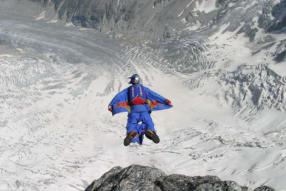Wingsuit Flights
 Does the wingsuit fly or only reduces vertical speed due to aerodynamic drag? It really flies, because just its area is not enough for such a decrease in vertical speed and smooth planning.
Does the wingsuit fly or only reduces vertical speed due to aerodynamic drag? It really flies, because just its area is not enough for such a decrease in vertical speed and smooth planning.
But only gravity allows flying wingsuit. The vertical fall caused by the force of gravity of the wingsuit turns into horizontal (as far as possible) flight. The same principles underlie gliders, hang gliders and wing parachutes. Wingsuit flies because it has an aerodynamic profile, just like an airplane wing, parachute wing, or even Space Shuttle (space shuttle) In reality, in shape and flight characteristics, the wings are closer to the shuttle than to other aircraft.
Wingsuit Flights
Wingsuit, like other aerodynamic profiles, creates lift and drag. The better the flight, the better the relationship between lift and drag. For a specific aerodynamic shape, this relationship between lift and drag varies with speed. The speed at which the best quality is usually 30-40% higher than the vertical speed (ask any glider about the minimum and best planning speed, in 90% the answer will be 55-65 km / h minimum speed and 80-90 km / h best planning speed) . Flying with the best planning speed allows you to cover the maximum distance. Flying at a lower or higher speed means a shorter distance. Every flying body has a minimum speed, which creates sufficient lift for flight. Below this speed, the lift is insufficient and the fall begins (Remember, parachutes also stop and lose lift. The horizontal speed in this case is close to zero, and the vertical doubles). The same goes for wingsuit. To fly, he needs speed. The question is what is the best speed for better planning. This is a tricky question, since Wingyut is not a tough profile. Each pilot flies using slightly different positions of the arms, legs and body. This means that all pilots have different profiles. Add different weight, height and size of the arms and legs and the problem becomes even more difficult. That is why it is very difficult to determine the minimum speed for a wingsuit. But there are general rules for any flying body. The relationship between the effective wing area and the weight of a flying body is called wing loading.
Most skydivers are familiar with these terms in relation to their parachutes. A high-load dome will fly faster, but its vertical speed will also be higher. Today wing type parachutes have between 0.5 and 3.0 pounds per square foot. Hang glider loads of approximately 1.2 and 1.5 pounds per square foot. and their minimum speed is about 35 km / h (22 mph). Cessna aircraft have a load of 20 lbs / sqft and their minimum speed is 80-90 km / h (50–55 mph).
The space shuttle, with its short wings and extremely high load, lands at a speed of more than 350 km / h (220 mph !!!).
Wingsuit average pilot has an area of 15-16 sq.ft, the weight of the pilot 170-190 pounds. Thus, the loading of the wingsuit is 10.5 – 12.5 lbs / sqft, ten times higher than the parachute. The simplest mathematics tells us that when loading ten times, the minimum speed will be (roughly) 3 times higher. Wingsuit flight studies have shown that better planning is achieved at a speed of 130 km / h (75 mph).
The vertical speed is 40-50 km / h. Aerodynamic quality between 2 and 2.5. You can fly at a lower descent speed, but the result will be a significantly lower horizontal speed and worse glide path.




